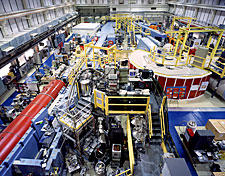FY07: NIST Center for Neutron Research (NCNR) Expansion and Reliability Improvements: A National Need
Problem/Challenge

The NIST Center for Neutron Research (NCNR) is the nation's leading neutron facility, serving more scientists and engineers (over 2,000 annually) than all other U.S. neutron research facilities combined. The NCNR is especially valued for its "cold" (low-energy) neutron source that greatly increases the utility of the neutron beam, particularly in biotech and materials research.
While the NCNR is widely regarded as the most cost-effective and efficiently managed neutron facility in the United States, it cannot possibly meet the demand for such a critical research tool. A major new Department of Energy neutron source is under construction, but even with that added capacity the United States will remain significantly behind Europe and Asia in neutron research capabilities, a fact highlighted in a 2002 study by the Office of Science and Technology Policy.
Proposed NIST Program
This combined research and facilities-construction initiative begins a planned five-year program to expand significantly the capacity and capabilities of the NCNR to help meet this pressing national need. The project includes the development of a new neutron cold source together with a new 18,000 sq. ft. guide tube hall, guide tube systems, and new neutron instruments.
In FY 2007, the project will focus on:
- development and installation of the improved cold source,
- development of improved neutron beam handling systems to take advantage of the new source,
- development of new instrumentation for the expanded facility, and
- architectural and engineering design for the new guide hall.
This initiative also will fund modernization upgrades to the NCNR's control systems to ensure the long-term safe and reliable operation of the facility over the next 20 years.
Expected Impacts
Potential benefits include:
- a new generation of world-class instruments directly supporting the needs of science and
industry, - an increase in the overall measurement capacity of the NCNR by more than 25 percent,
- the ability to serve at least 500 additional researchers each year, and
- increased operational effectiveness.

